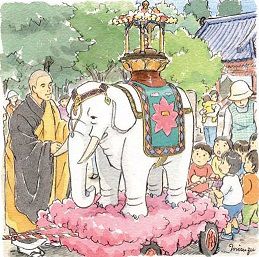What day is April 8th in the Buddhist calendar ? What do Japanese people do to celebrate this date ? Seyama sensei introduces this interesting topic below and helps to you learn Japanese vocabulary and about Japanese culture. Listen to the YouTube video read by JOI's staff.
花まつり
The Flower Festival

By SEYAMA Shizuka

4月8日は花まつりです。 みなさんは、「花まつり」と聞いて、何をイメージしますか? 桜の木の下で食事をしたり、お酒を飲んだりするのは、祭りのようですが「花見」ですね。 「花まつり」というのは、釈迦が生まれた日を祝う仏教の祭りです。
日本では、お寺やその近くの幼稚園などに春の草花で作ったお堂をまつります。 甘茶というお茶をお堂の中の仏像にかけたり、みんなで飲んだりして祝います。 甘茶は甘くて苦くて、不思議な味がします。
子どもたちは、平安時代の着物を着て、白い象の山車を引いて歩きます。 釈迦のお母さんが妊娠したときに、白い象の夢を見たことから、今でも白い象は縁起のいいものなのです。
わたしも子どものころに白い象の山車を引いたことがあります。 きれいな着物が着られるし、お化粧もできるし、甘茶のキャンディーももらえるので、わたしは花まつりが大好きでした。
最近では、花まつりを見る機会が減ってしまいましたが、大きいお寺へ行けば今でも行われています。機会があれば、行ってみてくださいね。
To listen to this blog, please watch our Youtube video.
4月(しがつ)8日(ようか)は花(はな)まつりです。 みなさんは、「花(はな)まつり」と聞(き)いて、何(なに)をイメージしますか? 桜(さくら)の木(き)の下(した)で食事(しょくじ)をしたり、お酒(さけ)を飲(の)んだりするのは、祭(まつ)りのようですが「花見(はなみ)」ですね。 「花(はな)まつり」というのは、釈迦(しゃか)が生(う)まれた日(ひ)を祝(いわ)う仏教(ぶっきょう)の祭(まつ)りです。
日本(にほん)では、お寺(てら)やその近(ちか)くの幼稚園(ようちえん)などに春(はる)草花の(くさばな)で作(つく)ったお堂(どう)をまつります。 甘茶(あまちゃ)というお茶(ちゃ)をお堂(どう)の中(なか)の仏像(ぶつぞう)にかけたり、みんなで飲(の)んだりして祝(いわ)います。 甘茶(あまちゃ)は甘(あま)くて苦(にが)くて、不思議(ふしぎ)な味(あじ)がします。
子(こ)どもたちは、平安時代(へいあんじだい)の着物(きもの)を着(き)て、白(しろ)い象(ぞう)の山車(だし)を引(ひ)いて歩(ある)きます。 釈迦(しゃか)のお母(かあ)さんが妊娠(にんしん)したときに、白(しろ)い象(ぞう)の夢(ゆめ)を見(み)たことから、今(いま)でも白(しろ)い象(ぞう)は縁起(えんぎ)のいいものなのです。
わたしも子(こ)どものころに白(しろ)い象(ぞう)の山車(だし)を引(ひ)いたことがあります。 きれいな着物(きもの)が着(き)られるし、お化粧(けしょう)もできるし、甘茶(あまちゃ)のキャンディーももらえるので、わたしは花(はな)まつりが大(だい)好(す)きでした。
最近(さいきん)では、花(はな)まつりを見(み)る機会(きかい)が減(へ)ってしまいましたが、大(おお)きいお寺(てら)へ行(い)けば今(いま)でも行(おこな)われています。 機会(きかい)があれば、行(い)ってみてくださいね。
The Flower Festival
April 8th is the Flower Festival day. When you hear 'Flower Festival', what images come to mind ? Eating and drinking sake under the Cherry Blossom trees, sounds like a festival, but this is called 'Hana-mi' or Cherry Blossom-viewing. The 'Hana Matsuri' or Flower Festival is a Buddhist festival celebrating the day that Buddha was born.
In Japan, we enshrine small 'Otou' or shrines made from spring flowering plants in temples and nearby kindergartens. A type of tea called 'Ama cha' is sprinkled over the statue inside the shrine, and drank by everyone in celebration. 'Ama cha' or hydrangea tea has a strange taste that is both sweet and bitter.
Children dress up in Heian period style kimonos and pull around floats of white elephants. When Buddha's mother was pregnant ,it was said that she had a dream of a white elephant, so even today white elephants are seen as good omens.
When I was a child I had the experience of pulling a float of a white elephant before. I used to love the Flower Festival because you got to wear a beautiful kimono, got to wear make-up, and received Ama-cha flavored candy too.
Recently, the opportunities to see the 'Hana Matsuri' are decreasing, but if you go to a large temples they still hold the festival even now . If you have a chance, please go and have a look.
祭(まつ)り festival;feast
花見(はなみ)a cherry blossom-viewing picnic
釈迦(しゃか)Buddha
祝(いわ)う celebrate
仏教(ぶっきょう) Buddhism
幼稚園(ようちえん)preschool ; infant school ; kindergarten
お堂(どう) Hall ; the place to put image of Buddha
まつる enshrine
甘茶(あまちゃ) hydrangea tea
仏像(ぶつぞう) Image of Buddha
かける squirt ; water ; put
苦(にが)い bitter
不思議(ふしぎ) wonder; strange ; mysterious
平安時代(へいあんじだい) Heian Period(794-1185)
山車(だし) float ; dashi
妊娠(にんしん) pregnancy
縁起(えんぎ) omen ; lucky
化粧(けしょう) makeup
機会(きかい) chance ; opportunity



 Start Now with 2 Trial Lessons for $9 or 900 yen
Start Now with 2 Trial Lessons for $9 or 900 yen